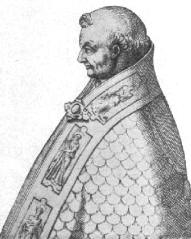 The pontificate of Stephen X marks a step forward in the fight for reform.
Preceding popes had struck hard at simony and clerical marriage. Now the ax
began to swing at the root --lay control of church offices. It is true that the
strong hand and good heart of Henry III had rescued the papacy from
irresponsible Roman lords. Still imperial control of the papacy was dangerous,
and lay control of any church position from pope to abbot was not only an evil,
but a root of evils.
The pontificate of Stephen X marks a step forward in the fight for reform.
Preceding popes had struck hard at simony and clerical marriage. Now the ax
began to swing at the root --lay control of church offices. It is true that the
strong hand and good heart of Henry III had rescued the papacy from
irresponsible Roman lords. Still imperial control of the papacy was dangerous,
and lay control of any church position from pope to abbot was not only an evil,
but a root of evils.
At the death of Victor II the situation favored a move toward papal
independence. Henry IV was a small boy. His mother, the empress-regent Agnes,
was not likely to raise too great a stir if a pope were elected without waiting
for her approval. Then too, the Romans acted shrewdly. They elected Cardinal
Frederick, abbot of Monte Cassino and brother of Godfrey, duke of Lower Lorraine
and Tuscany. If anyone could make an independent election stick, it would be a
clergyman with such very powerful connections.
The Romans' choice was good in many ways. Frederick was the son of Gozelon, duke
of Lower Lorraine. After studies at St. Lambert's in Liege, Frederick became a
canon, and then archdeacon of that Church. St. Leo IX made him chancellor and
librarian of the Apostolic See. He became an important aid to the great
reforming pope. St. Leo sent him to Constantinople on the mission which ended so
sadly in the Eastern Schism. On his return, Frederick was attacked by a robber
baron and stripped of all the treasures given to him by Emperor Constantine.
Then, learning that Emperor Henry III was angry with him, Frederick retired to
Monte Cassino and became a monk.
Elected abbot, he was consecrated by Pope Victor II and made cardinal- priest of
St. Chrysogonus. Frederick was consecrated pope as Stephen X because his
election took place on August 2, 1057, Pope St. Stephen's feast day. Stephen
gathered around him the great reformers of the age. He forced the fiery monk of
Fonte Avellano, St. Peter Damian, to become cardinal-bishop of Ostia. He sent
Hildebrand to smooth over the free election with Empress-Regent Agnes. And after
the capable monk succeeded in this delicate mission, he was sent into France to
push on the work of reform. The condition of the clergy in Milan was so bad that
the city might be considered a capital of the antireform party. The Milanese
people, however, rose against their unworthy pastors, and though given the
contemptuous name of "patari", i.e., ragamuffins, they made matters hot for the
abuse-ridden clergy.
While Pope Stephen moderated the violence of these eleventh- century vigilantes,
he approved of their association. For some reason, possibly to wage war on the
troublesome South Italian Normans, Stephen asked the monks of Monte Cassino to
lend him all their gold and silver. But when he saw that the monks were less
than delighted with the proposal, the good Pope relented and let them bring
their treasures back.
Like his German predecessors, Stephen was soon sick. He died on a trip to
Tuscany on March 29, 1058. To the Romans he left a legacy of good advice-- not
to elect a successor until the return of Hildebrand.
Excerpted from "Popes
Through the Ages" by Joseph Brusher, S.J.

